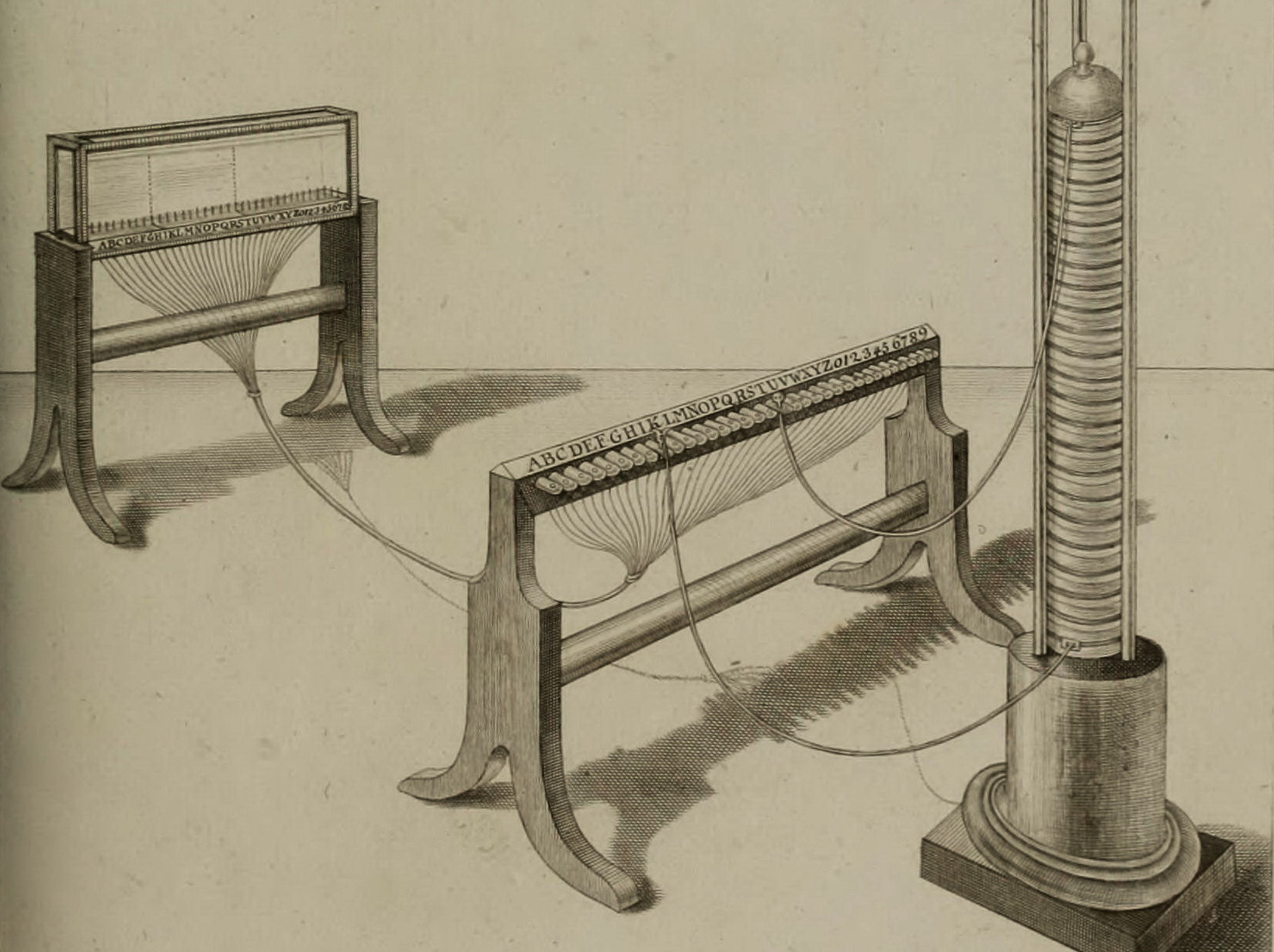Bubble Telegraph
This is one of the first attempts to use electricity to transmit information when there is already electricity, and what to do with it is still not entirely clear.

In a bubble telegraph, each letter and number corresponds to its own electric wire. At the receiving station, the wires were led into a glass aquarium vessel with acidified water. When current was supplied through the wire on the transmitter, hydrogen bubbles were released from the corresponding contact on the receiver due to electrolysis and indicated that this letter was transmitted.
A bit of historical background
When Austria invades Bavaria in 1809, the Bavarian king Maximilian calls for help to his ally Napoleon. France by that time was equipped with optical telegraph towers, and the French units came to the rescue very quickly.
King Maximilian is impressed by the capabilities of the optical telegraph, but it is highly dependent on the weather and time of day. The king instructs the Bavarian Academy of Sciences to think about an alternative, and Academy member Dr. Sömmerring decides to try electric current.
Such attempts by then more than 50 years , but Semmering uses the latest scientific discoveries. Firstly, a cell was recently invented - a volt pole. Secondly, although Faraday has not yet formulated the laws of electrolysis, the phenomenon of hydrogen evolution when passing current through water has been known for several years. Semmering is moving from fundamental to applied science.
How it worked
The caller connected two signal wires to the battery.

At the receiving station, with two corresponding contacts (the leftmost in the “aquarium”), bubbles were released that accumulated under the “spoon”. When there was enough gas, the spoon popped up, the ball at the other end fell and hit the bell. The telegraph operator woke up and realized that someone wanted to contact him.
After that, the transmitter in series connected the current source with the letters that it wanted to transmit, and the receiver monitored where the bubbles were going and recorded the message.
Using the current in both directions, Semmering could transmit two letters simultaneously. At the transmitting end, one wire was connected to the positive and the other to the negative pole of the voltaic column. Accordingly, at the receiving end, the letter designation of the wire was first recorded, from which more gas was separated - hydrogen, and then the second wire, from which half as many bubbles - oxygen were separated.

Remark:

The system was tested for operability at a distance of several kilometers, one copy was sent to the French Academy of Sciences, it was repeatedly shown to the crowned persons, the numbers were removed, the signal wire got rid of ... But it did not work out. And in 1820, Oersted noticed a deviation of the compass needle next to the conductor, and the development of the telegraph went a different way.

In a bubble telegraph, each letter and number corresponds to its own electric wire. At the receiving station, the wires were led into a glass aquarium vessel with acidified water. When current was supplied through the wire on the transmitter, hydrogen bubbles were released from the corresponding contact on the receiver due to electrolysis and indicated that this letter was transmitted.
A bit of historical background
When Austria invades Bavaria in 1809, the Bavarian king Maximilian calls for help to his ally Napoleon. France by that time was equipped with optical telegraph towers, and the French units came to the rescue very quickly.
King Maximilian is impressed by the capabilities of the optical telegraph, but it is highly dependent on the weather and time of day. The king instructs the Bavarian Academy of Sciences to think about an alternative, and Academy member Dr. Sömmerring decides to try electric current.
Such attempts by then more than 50 years , but Semmering uses the latest scientific discoveries. Firstly, a cell was recently invented - a volt pole. Secondly, although Faraday has not yet formulated the laws of electrolysis, the phenomenon of hydrogen evolution when passing current through water has been known for several years. Semmering is moving from fundamental to applied science.
How it worked
The caller connected two signal wires to the battery.

At the receiving station, with two corresponding contacts (the leftmost in the “aquarium”), bubbles were released that accumulated under the “spoon”. When there was enough gas, the spoon popped up, the ball at the other end fell and hit the bell. The telegraph operator woke up and realized that someone wanted to contact him.
After that, the transmitter in series connected the current source with the letters that it wanted to transmit, and the receiver monitored where the bubbles were going and recorded the message.
Using the current in both directions, Semmering could transmit two letters simultaneously. At the transmitting end, one wire was connected to the positive and the other to the negative pole of the voltaic column. Accordingly, at the receiving end, the letter designation of the wire was first recorded, from which more gas was separated - hydrogen, and then the second wire, from which half as many bubbles - oxygen were separated.

Remark:

The system was tested for operability at a distance of several kilometers, one copy was sent to the French Academy of Sciences, it was repeatedly shown to the crowned persons, the numbers were removed, the signal wire got rid of ... But it did not work out. And in 1820, Oersted noticed a deviation of the compass needle next to the conductor, and the development of the telegraph went a different way.
